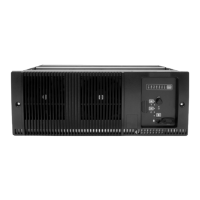18 Description TB9100/P25 CG/P25 TAG Installation and Operation Manual
© Tait Limited March 2014
12V DC PA-Only Base Station/Repeater
The base station can be provided without a PMU for those who prefer to
use an external third party power supply. The 12V DC input is connected
directly to the 12V PA. This is a variant of the PA that includes a boost
regulator board. This board converts the 12V nominal DC input to a
28VDC output to power the PA circuit boards. The boost regulator board
also provides a 12VDC output to power the reciter. Customers must provide
their own power supply. Without a PMU, the base station can only be
powered by DC and cannot carry out its power management functions.
Receive-only Base Station
The base station can be provided as a receive-only variant in systems that
need sites to enhance the receive coverage. This consists of a single reciter
in a subrack, with or without power management. The exciter is present but
not licensed to transmit.
Console Gateway
A console gateway consists of a gateway module in a subrack, optionally
with a PMU. A subrack can contain several gateway modules. The console
gateway’s analog line connects to the dispatch system, and its Ethernet
interface connects to the Tait P25 Network. It has no RF functionality.
Encrypted voice quality is indistinguishable from unencrypted.
The console gateway supports Project 25 compliant DES (via the basic
encryption license) and AES (Advanced Encryption Standard) with the AES
license.
Since the control panel is another analog access point, decryption at the
control panel could be a point of insecurity in the system. For this reason,
there is no encryption or decryption to the control panel. The control panel
speaker plays unencrypted speech (if that is present at the gateway). If the
gateway is receiving or transmitting encrypted speech, the speaker simply
produces encrypted noise.
Trunked Analog Gateway
A trunked analog gateway consists of a gateway module in a subrack,
optionally with a PMU. A subrack can contain several gateway modules. A
trunked analog gateway differs from a console gateway only in the software
feature licenses it has. The trunked analog gateway’s analog line connects to
the dispatch system, and its Ethernet interface connects (via the CSSI
protocol) to an RFSS controller in a Tait P25 Trunked Network. It has no
RF functionality.

